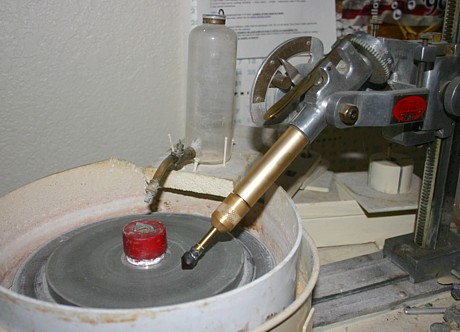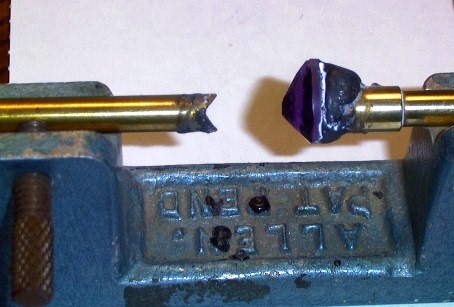The starting point for cutting a gem is, of course, the rough. This particular stone is a piece of amethyst from Brazil that I purchased some years ago. The amethyst miners actually take the rough crystals of amethyst and strike it with hammers to knock off the flawed portions of the stone. This produces a clean piece of rough that has broken edges as shown in the photo.
The rough gem is then sawn and ground into a shape close to that of the finished stone. The "shaped" rough is called a preform. A big key at this first step is to identify and remove any remaining flaws and then find the shape of the rough that will yield the largest stone out of what remains. The photo is enlarged of course, but the actual stone was of good size, slightly over 3/4 of an inch long.
The preform is sawed in diamond grit saws and ground on coarse grinding wheels. One side of the stone is cut with a flat surface - this will eventually become the table or main flat facet on top of the stone. In the beginning, this main flat facet is used to orient the rest of the stone. At this stage the stone is called a preform, and you can see what the final shape will be. So our pear shaped preform is ready to be "glued" to the brass dop stick. The flat tops of these dops are matched to the flat table facet on the stone. The glue that is used is actually a special high temperature wax. Some of this wax (which is black) is still on the brass dop from a previous use of the dop.
This is the dopped preform has now been glued flat side down on to the brass dop stick. The rough end of the stone will be cut away to form the pointed base of the stone. Contrary to what a lot of people think, faceting is NOT a process of chipping or cleaving with a little hammer. This process is used for diamonds only and then only in place of sawing to prepare them for cutting. Regular faceting is a process of grinding and polishing - this is true with both diamonds as well as colored stones. One or two different grit flat lap wheels are used to grind in the facets and a polishing lap is used to put a final polish on them. Diamonds are cut and polished on one lap.

Here the preform is being cut and polished on a lap on my homemade faceting machine. The bottom part of the stone is cut first. Each flat facet is cut on a grinding lap, and then the lap is changed and each facet is polished on a polishing lap. The location of each is set by the toothed gear and angle protractor and the hand set. This is a polishing lap on the machine in the photo. My machine is partly home made. The mast and hand set are by master, but the rest of the machine is home made. The mast set up is also old - it dates from the 1950s. In spite of that, it still works quite well. Twenty four facets on the cullet have now been individually cut and polished.

The bottom part (also called the cullet) of the stone has now been cut and polished - all the facets on the base are now polished and complete. Now it is time to cut the upper portion of the stone, known as the crown. In order to do that, the stone must be transferred to another dop. The new dop will hold the base of the stone so that the top portion is exposed for cutting and polishing. As the first dop had a flat surface to match the table facet, the second dop has a "V" shaped notch to match the "V" shaped bottom of the stone.
The stone has now been transferred from the first dop in order to turn it over for polishing the top side of the stone - called the crown. The first facet to be cut and polished on the crown side is the top flat or table facet. In order to do this, a special 45 degree dop holder is needed to allow us to reach the table. This photo shows the table facet complete and polished but none of the rest of the other top (or crown) facets cut in - they are to be cut and polished next.
After all the facets are cut in and polished, the stone is removed from the dop stick and cleaned to remove any remaining wax. The wax can be softened by gentile heat, and most of the wax removed. The rest of the wax used in this process washes off the stone when it is soaked in alcohol.
Step
Seven: Set the Stone in Nice Jewelry
This is the finished Amethyst stone - all facets complete and the stone removed from the dop sick, cleaned and set in fine jewelry. The small light colored specks across the middle of the stone are not inclusions, they are light reflections. I didn't do this piece of jewelry work, but I cut this stone for a friend to give to his wife for Christmas - he had a jeweler set it. It turned out very nice, didn't it?
So there it is, the whole process from a lump of purple chunky glass like stone, to a beautiful gem.
